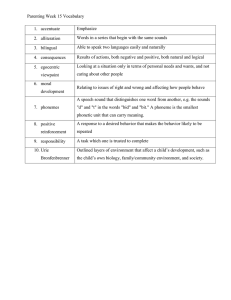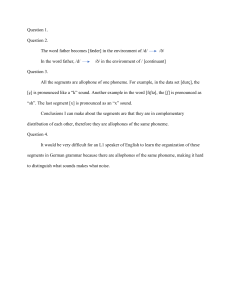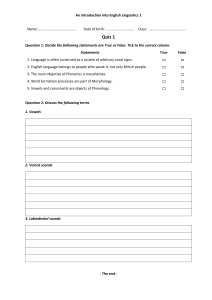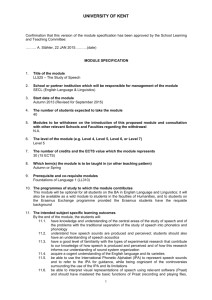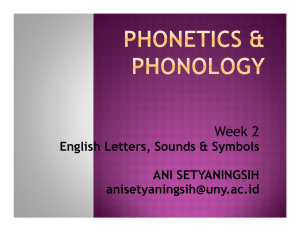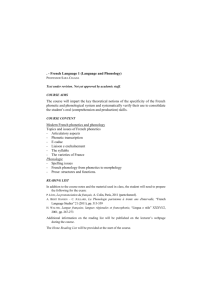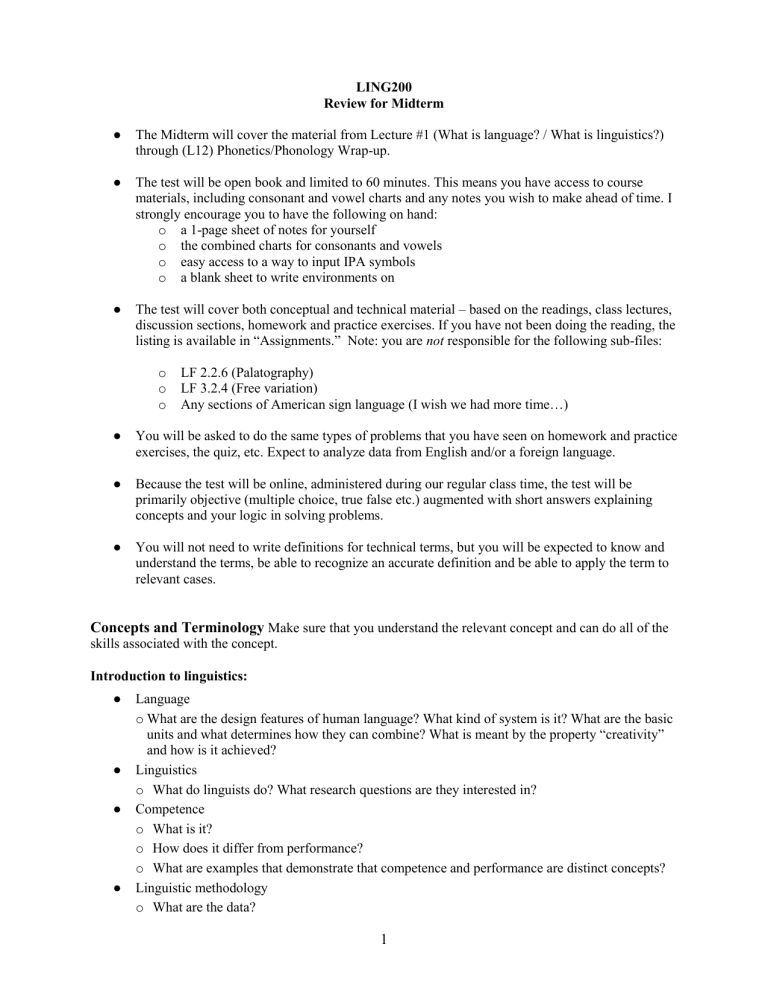
LING200 Review for Midterm ● The Midterm will cover the material from Lecture #1 (What is language? / What is linguistics?) through (L12) Phonetics/Phonology Wrap-up. ● The test will be open book and limited to 60 minutes. This means you have access to course materials, including consonant and vowel charts and any notes you wish to make ahead of time. I strongly encourage you to have the following on hand: o a 1-page sheet of notes for yourself o the combined charts for consonants and vowels o easy access to a way to input IPA symbols o a blank sheet to write environments on ● The test will cover both conceptual and technical material – based on the readings, class lectures, discussion sections, homework and practice exercises. If you have not been doing the reading, the listing is available in “Assignments.” Note: you are not responsible for the following sub-files: o o o LF 2.2.6 (Palatography) LF 3.2.4 (Free variation) Any sections of American sign language (I wish we had more time…) ● You will be asked to do the same types of problems that you have seen on homework and practice exercises, the quiz, etc. Expect to analyze data from English and/or a foreign language. ● Because the test will be online, administered during our regular class time, the test will be primarily objective (multiple choice, true false etc.) augmented with short answers explaining concepts and your logic in solving problems. ● You will not need to write definitions for technical terms, but you will be expected to know and understand the terms, be able to recognize an accurate definition and be able to apply the term to relevant cases. Concepts and Terminology Make sure that you understand the relevant concept and can do all of the skills associated with the concept. Introduction to linguistics: ● ● ● ● Language o What are the design features of human language? What kind of system is it? What are the basic units and what determines how they can combine? What is meant by the property “creativity” and how is it achieved? Linguistics o What do linguists do? What research questions are they interested in? Competence o What is it? o How does it differ from performance? o What are examples that demonstrate that competence and performance are distinct concepts? Linguistic methodology o What are the data? 1 Ling 200 ● o Why do we use speaker judgments? o Why do we focus on spoken instead of written versions of language? Prescriptive Grammar vs. Descriptive Grammar vs. Mental Grammar o Why do we think there are rules in the mental grammar? Phonetics: ● What do phoneticians study? How does this relate to the larger goals of linguists? ● IPA (what it is and motivation for) ● Features for consonants (places of articulation, manners, voicing) ● Features for vowels (height, tense/lax, rounding, front/back) ● Consonant vs. vowel (definition in terms of how the sounds are produced) Phonology: ● What do phonologists study? How does this relate to the larger goals of linguists? ● Phoneme, allophone (and use of / / vs. [ ]) ● Minimal pairs ● Overlapping vs. complementary distribution ● Distribution statements vs. rules (what is the difference, what does each do?) ● Phonological rules (a phoneme gets changed to be pronounced as a phone with different features in a restrictive environment; importance of features/natural classes) ● Types of phonological rules: assimilation, dissimilation, deletion, insertion, metathesis Skills: Phonetics: ● Do phonetic transcription. Given an English word, you should be able to give the phonetic transcription, and vice versa (i.e. know the symbol-sound correspondence for all of the English sounds in the phonetic alphabet (IPA symbols for English)). ● Describe a vowel in terms of relevant features (tongue height, tongue front or back? tense vs. lax, rounding). (Have your chart on hand.) ● Describe a consonant in terms of place and manner of articulation and presence or absence of voicing. (Have your chart on hand.) Phonology/allomorphy: ● Identify what feature(s) a group of sounds has in common (natural class). ● Analyze data (from English and other languages) and give a phonemic analysis: o Determine whether two phones (sounds) are allophones of a single phoneme or of two different phonemes. o If the sounds are in complementary distribution, you should be able identify a complementary distribution statement, state what the phoneme is, give a rule (using features and rule format) describing the pattern for deriving the allophone from the phoneme. o If the sounds constitute separate phonemes, you should be able to provide evidence for this (minimal pairs), explain what overlapping distribution means and identify an overlapping distribution statement. o Provide the mental and actual representation of a word e.g. /θænk/ for [θæŋk] <thank> 2 Ling 200 Suggestions & resources to prepare for the test: Here is the organization of the Modules: ● Module 3 (current) ● General Course Info. ● Module 2 ● Module 1 Internal to each subject module: ● Lecture Slides ● Assignments ● General Support Materials - including extra practice opportunities ● ● ● ● For conceptual issues and problem-solving techniques, it would be wise to go to office hours with questions. Review all of the practice and homework problems. If you did not do well on an assignment, make sure you read the feedback and go to office hours. Go through the Lecture slides and make sure that you understand the points that were made. Go back and reread the chapters of the text. Additional Practice ● Phonetics: take any sentence from any source and pick 1-syllable words to transcribe. ● “Phonology: Extra Practice” has 4 problems. o The Mokilese problem has a solution posted - which you should consult only after you have worked the problems through by yourself. o If you have questions about Slovak, Korean or Papago, bring them to the Discussion Review on Friday. 2. Here are some words that have undergone a phonological change. Which sound is changing how and what is the name of the type of change (assimilation, dissimilation, deletion, insertion, or metathesis)? ● /fɪfθs/ pronounced as [fɪfts] ● /θænk / pronounced as [θæŋk] ● /kæmɛɹɑ/ pronounced as [khæmɹɑ] (no do not focus on the aspiration) ● /æstɛɹisk/ pronounced as [æstɛɹiks] ● /sʌmθɪŋ/ pronounced as [sʌmpθɪŋ] 3

